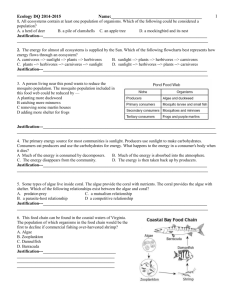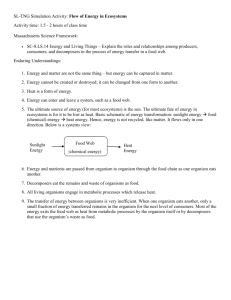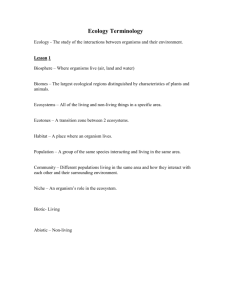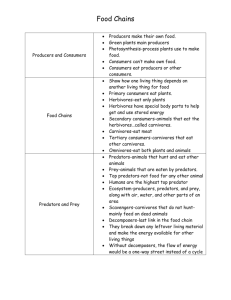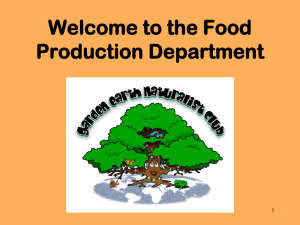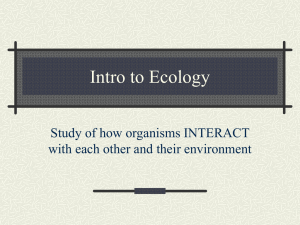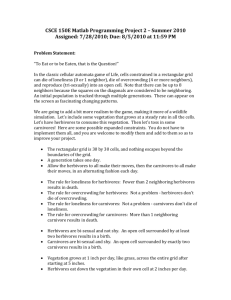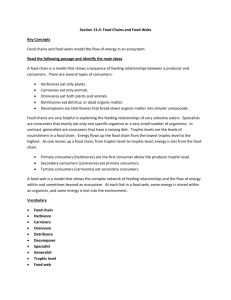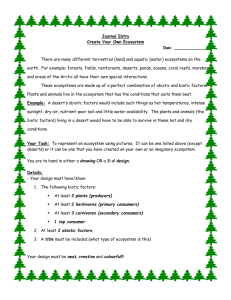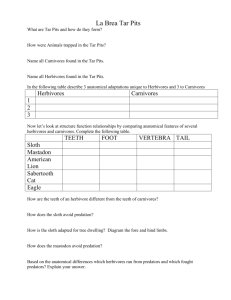Student Worksheet Solutions
advertisement
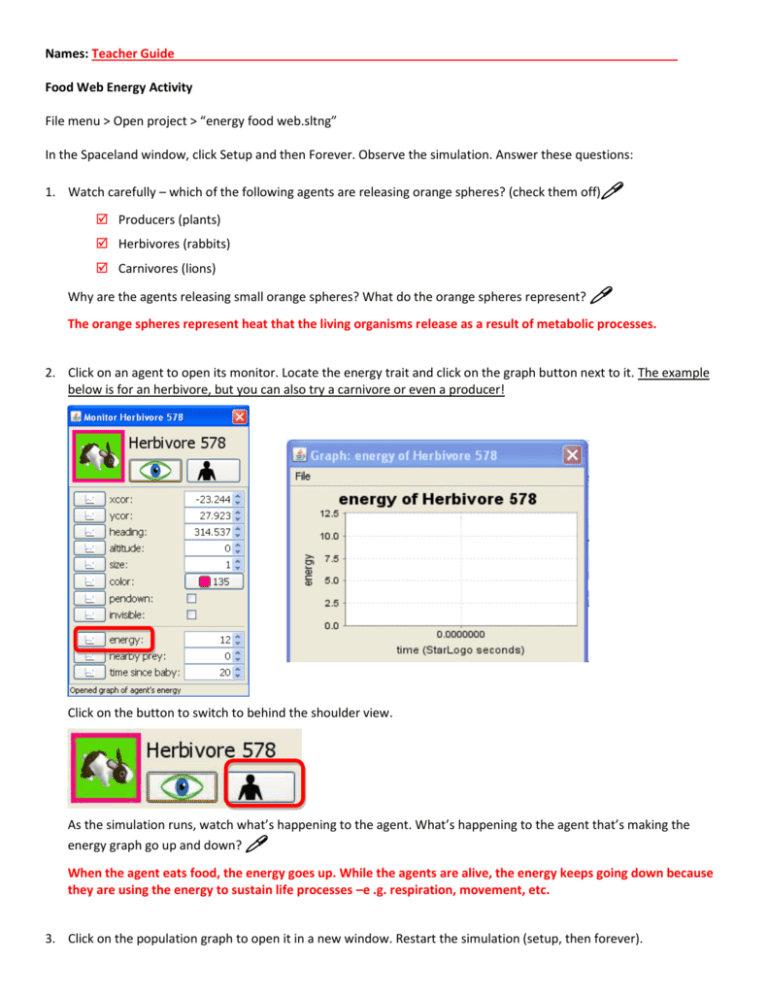
Names: Teacher Guide Food Web Energy Activity File menu > Open project > “energy food web.sltng” In the Spaceland window, click Setup and then Forever. Observe the simulation. Answer these questions: 1. Watch carefully – which of the following agents are releasing orange spheres? (check them off) Producers (plants) Herbivores (rabbits) Carnivores (lions) Why are the agents releasing small orange spheres? What do the orange spheres represent? The orange spheres represent heat that the living organisms release as a result of metabolic processes. 2. Click on an agent to open its monitor. Locate the energy trait and click on the graph button next to it. The example below is for an herbivore, but you can also try a carnivore or even a producer! Click on the button to switch to behind the shoulder view. As the simulation runs, watch what’s happening to the agent. What’s happening to the agent that’s making the energy graph go up and down? When the agent eats food, the energy goes up. While the agents are alive, the energy keeps going down because they are using the energy to sustain life processes –e .g. respiration, movement, etc. 3. Click on the population graph to open it in a new window. Restart the simulation (setup, then forever). Let the simulation run for about 400 StarLogo seconds (see x-axis). How do the populations of herbivores and carnivores change over time? The carnivore population stays about the same. The herbivore population goes up and eventually moves up and down within a certain range. An ecosystem is stable if the populations remain within some predictable range. This stability is called “dynamic equilibrium.” Write down the approximate range of populations of herbivores and carnivores that the ecosystem can support with stability. Notice that the stable population range of herbivores is not the same as the starting population on the population slider. Herbivores – approximately 70-75. Carnivores – approximately 5. 4. Click on “toggle sunlight” to turn sunlight off. You should see in the status bar: “sunlight = false.” Before you run the simulation, predict what you think will happen if there is no sunlight (no new energy being added). If there is no sunlight, everything will eventually die. Run the simulation. Describe what happens when no more new energy is added to the system. Who gets affected first? What eventually happens to the ecosystem? The rabbits get affected first. Once they eat all the berries, since the plants aren’t producing any more berries, the rabbits will all die. Then the lions will all die because there aren’t any rabbits to eat. Finally, the plants will die – their energy use is slower compared to the consumers, so they are the last ones to run out of energy. Click on the “toggle sunlight” button again to turn the sunlight back on. The status bar should say: “sunlight = true.” SWITCH NAVIGATOR AND DRIVER ROLES!! 5. Move the sunlight slider to the right to increase the amount of sunlight energy available. How does the increase affect the ecosystem? Increasing the sunlight increases the populations of herbivores and carnivores. What do you think would happen if you turn down the sunlight slider? Try it and compare the results with your prediction. Decreasing the sunlight decrease the populations of herbivores and carnivores. 6. Click on the total energy graph to track the amount of energy for each population. Run the simulation. Why is the total energy of the carnivores less than the herbivores, which is less than the producers? Why doesn't all the energy get transferred to herbivores and then to carnivores? Not all the rabbits get eaten by lions. Some of them just die because they couldn’t find food to stay alive. Also, plant, rabbits, and lions are all using energy for life processes, which releases heat that leaves the food web system, and thus doesn’t get transferred to the next higher level. Where is the "missing" energy? The energy leaves the system as heat. 7. Is it possible to have an ecosystem with equal numbers of producers, herbivores and carnivores? Why or why not? [students’ answers may vary] Set all the population values to the same value (e.g., population = 100). To quickly set the population, you can click on the top right corner of the slider and type in the number you want. But make sure that the number you type is within the minimum and maximum values of the slider. If it isn’t, then you need to adjust the minimum and maximum values. Run the simulation and explain what happened. All the rabbits get eaten up right away. Then the lions slowly starve to death. 8. In this ecosystem, 500 producers are needed to support 70 herbivores, which supports 5 carnivores, when the sunlight is set at 8. What happens if you change one of the population variables (minimum 1; make sure sunlight=8)? Does a sudden drop in one population destabilize the ecosystem or is balance eventually restored? Write down your population values. Answers may vary. E.g. I increased the number of starting herbivores to 150, keeping everything else the same. When I ran the simulation, the high number of rabbits caused them to quickly deplete the food supply and die off quickly in large numbers. This caused the number of lions to decrease. Even when the rabbit population eventually went up again after the food had a chance to grow back, the lion population never quite recovered, and eventually all the lions died out. This made me theorize that maybe the small size of the lion population can’t withstand a huge drop in their prey population. So I increased the starting number of lions to 10, predicting that a slightly larger population of lions would be less sensitive to the drop in prey population due to over-foraging. I ran the simulation again and observed that the lion population was better able to stay alive while waiting for the herbivore population to reach equilibrium. Assuming that the sunlight stays the same (=8), what other sets of population numbers produce a stable ecosystem? You should run the simulation for at least 300 StarLogo TNG seconds (x-axis on the graph). Do both the herbivore and carnivore populations stabilize? What are the final stable populations? Answers may vary, but basically, the ratio should be something along the lines of: 100 producers to 20 herbivores to 1 carnivore. Students may start with different numbers, but the stable populations would roughly match that ratio. In any case, students should have a sense that it takes a lot of producers to support a smaller population of herbivores, which then support an even smaller population of carnivores. The goal of this exercise is to help students get a sense of relative population sizes. 9. If you want to increase the population of carnivores from 5 to 15, and keep that population fairly stable (that is, close to 15), how many more herbivores would you need? Is it enough just to increase the number of herbivores? If students simply tripled herbivores without increasing producers by the same ratio, they’ll see that the rabbits population crash very quickly after they quickly eat up all the food and starve, while also being quickly hunted by a larger group of carnivores. When the rabbit population drops, the lion population will also drop, and basically, the stabilizing populations will be what it was originally – 500 producers supporting 60-70 rabbits, which support about 5-8 lions. How many producers would you need? Theoretically, you would need 1500 producers. NOTE: Running the simulation with triple the number of each population may drastically slow down the computer due to the high memory usage. You may want to illustrate this point with smaller numbers – like 800 producers to 80 herbivores to 8 lions. 10. What is the effect on the ecosystem if the producers are suddenly wiped out (population = 0) from a disease or natural disaster? Rabbits would all die, followed by lions. 11. What happen to the other agents if the herbivores get wiped out (population = 0)? Lions would all die. Plants would keep producing berries, which would not be eaten. 12. What happens if the carnivores get wiped out (population = 0)? Herbivores and producers would keep each other’s population in balance. The stable number of herbivores without carnivores would be slightly higher than the stable number of herbivores with carnivores. 13. How does increasing or decreasing the sunlight affect the simulation? Increasing the sunlight increases the rate at which energy enters the system (i.e., more energy is transferred in each collision between sunlight spheres and plants). Hence, the increased amount of energy that’s available would increase all the populations, but still along the same ratios. Decreasing the amount of sunlight would decrease all populations, but would most affect the lion population, which is already so small to begin with.
